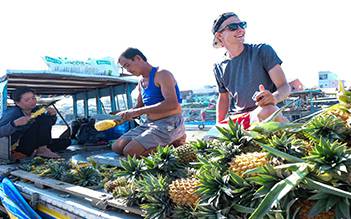Overview
Considered to be the most magnificent architecture in Hue citadel, Hue Royal Antiquities Museum is now a place to store royal artefacts, a memory of the golden age - a destination that you can visit in your Hue - Hoi An 3 days group tour.
Brief information about Hue Royal Antiquities Museum
The museum is directly under the management of Hue Monuments Conservation Center, located in a campus of about 6,500m2. The main exhibition building is Long An Palace and an outdoor display area. The main building has 128 precious wooden pillars, carved with the four sacred objects of Dragon - Unicorn - Turtle - Phoenix and over 1000 Chinese-style poems on the pillars.
Long An Palace was built in 1845, under the reign of the Nguyen Dynasty. Currently, the museum exhibits more than 300 artefacts of gold, chinaware, porcelain, Hue "phap lam" (copper or copper alloy), medical instruments, and costumes of the Nguyen dynasty, giving visitors an overview of Hue royal life.

Long An Palace
Located in the Citadel, it is the earliest museum established in Hue in 1923, with the first name of Musee ’Khai Dinh.
Before 1945, it was one of the brightest museums in Indochina and was known by many researchers as well as many universities around the world.
Currently, Hue Royal Antiquities Museum is located on Le Truc street, Thuan Thanh ward, Hue city. It is an important monument located in the Hue Imperial complex recognized by UNESCO as a world cultural heritage in 1993. The monument was also ranked nationally in 1997.
Architecture
The museum area is 6,330 m2, in which the main building in the middle has a surface area of 1,185m2 and several auxiliary areas used to store artifacts or as gardens, etc.
Ancient people were very reasonable when using Long An Palace as a museum. It is a magnificent ironwood structure, built in the style of the unique architecture of Hue. The palace is made with 128 columns. Interior and exterior decorations are incredibly vibrant, elegant, and rich in art.

The decoration on the roof of the museum
The interior of the project converges many decorative designs according to the artistic style, with techniques and materials such as embossing, the mosaic of pearl shell, ivory, nacre, etc. They are decorated on the boxes under the roof, above partitions, and doorways.
The top and the edge of the roof are decorated with the images of "two dragons disputing a pearl" and "four holy beasts." Many art researchers agree that it is "the most magnificent building in Vietnamese palaces.” Thus, Long An Palace is a precious treasure.
Artifacts
Presently, the Hue Royal Antiquities Museum is the place where most of the objects of the former Nguyen dynasty have been preserved with 700 artifacts, including pottery, glazed ceramics from the Ly Dynasty to the Nguyen Dynasty, Chinese, Japanese, and French ceramics, etc. It can be said that the museum is a collection of ceramics of the Nguyen Dynasty and other countries.
Experiencing the destruction of time and human greed, the number of artifacts here is not as intact as it used to be. But today, when going there, visitors can still admire hundreds of rare objects such as the throne, king's palanquin, queen's coats, shoes, paintings, poetry, chinaware, silverware, etc. displayed in this electricity.

The "Bleu de Hue"
Besides the exhibits, the museum also houses thousands of other artifacts, especially the blue glaze porcelain, commonly known as the "Bleu de Hue." It is a type of furniture made by high technology, booked by the Nguyen court from famous pottery furnaces in China, based on the preferences, designs, and sizes of each king of Vietnam.
As such, those old antiques are unique works. In the areas of ceramic glaze, there are also some production items in France, Japan, England, and America, etc.
About 100 sets of clothes of kings, queens, princes, mandarins, and soldiers are also being kept in the cloth store. Also, various unique handmade objects are considered invaluable.
In this museum, there is another storehouse of more than 80 collected Cham artifacts in the old Chau and Ly areas, brought from Tra Kieu during the archaeological excavations in 1927. Of which, the Cham artifacts have been evaluated by researchers as rare and precious cultural heritage.

Tourists can see the royal clothes in the museum
Thematic display areas
- Textile
- Regal game
- Costume of the Nguyen dynasty
- Antiquities in the Nguyen Dynasty monuments
- Collection of ceramic
- Collection of coins




